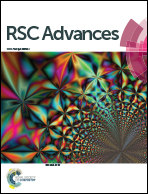One pot synthesis of gold hollow nanospheres with efficient and reusable catalysis†
Abstract
In this paper, gold hollow nanospheres (GHNSs) have been prepared by a one step method using 2-mercaptothiazoline as both a reductant and stabilizer. The gold hollow nanospheres were characterized by X-ray diffraction (XRD), X-ray photoelectron spectroscopy (XPS), transmission electron microscopy (TEM) and scanning electron microscopy (SEM) with energy-dispersive X-ray spectroscopy (EDX). The gold hollow nanospheres exhibit excellent catalytic activity toward the reduction of 4-nitrophenol and potassium hexacyanoferrate(III) by sodium borohydride in water. Kinetic investigations were carried out for the GHNSs-catalyzed reactions at different turns. Importantly, the catalyst, GHNSs, can be recycled and exhibits good reusability.


 Please wait while we load your content...
Please wait while we load your content...